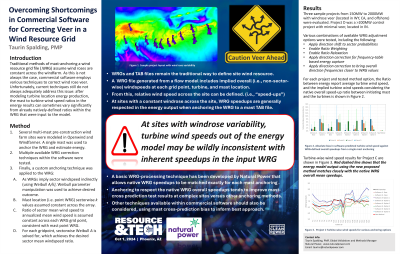Back

Novel Approaches to Addressing Spatial Model Wind Veer in Complex Terrain
Tuesday, October 1, 2024
5:00 PM – 6:00 PM MST
Location: Regency D


Taurin Spalding, PMP
Global Validations and Methods Manager
Natural Power
Seattle, Washington
Poster Presenter(s)
Presentation Description: Wind flow models have gotten increasingly more complex, and now commonly include predicted changes in the wind rose across a site, driven by complex terrain or broader atmospheric drivers. Because of this, traditional methods of anchoring a wind resource grid (.WRG) file to mast-observed direction data are no longer sufficient at some sites: this is driven by a difference in the WRG-inherent vs. Mast-observed directional weightings, where using the latter without regard to veer will result in predicted annualized wind speed ratios across the grid that could vary significantly from that which is already natively defined within the flow model.
Various correction methods have been employed in commercially available software to address this issue; however significant shortcomings of the software are still apparent.
In this discussion, Natural Power presents several case studies illustrating what the issue is, where it can occur, and a novel WRG-processing technique to resolve WRG-veer related issues in the mast-anchoring process. Taken a step further, Natural Power will highlight other potential shortcomings of the static/annualized WRG modeling approach, including an overview Natural Power's in-house python-based energy modeling tool suite, and how temporally variable wind flow and wake modeling may yield improved de-waking and energy estimates.
Learning obj
- Understand how to identify wind project sites in which changes in veer across a project site is expected
- Understand what limitations traditional WRG anchoring faces in commercially available software
-Learn what methods and tools can be used to address directional variability across a project site, as well as modeling approaches to dealing with temporally variable flow
Various correction methods have been employed in commercially available software to address this issue; however significant shortcomings of the software are still apparent.
In this discussion, Natural Power presents several case studies illustrating what the issue is, where it can occur, and a novel WRG-processing technique to resolve WRG-veer related issues in the mast-anchoring process. Taken a step further, Natural Power will highlight other potential shortcomings of the static/annualized WRG modeling approach, including an overview Natural Power's in-house python-based energy modeling tool suite, and how temporally variable wind flow and wake modeling may yield improved de-waking and energy estimates.
Learning obj
- Understand how to identify wind project sites in which changes in veer across a project site is expected
- Understand what limitations traditional WRG anchoring faces in commercially available software
-Learn what methods and tools can be used to address directional variability across a project site, as well as modeling approaches to dealing with temporally variable flow
